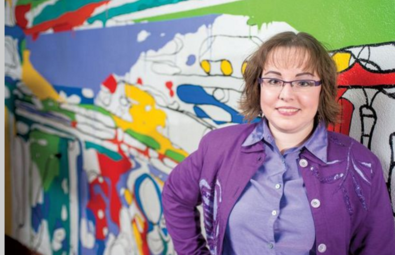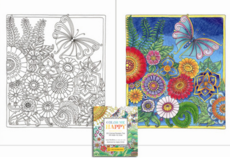Adults are finding coloring is more than an artistic release, but hold onto an array of health benefits.
Research in 2005 proved anxiety levels dropped when adults colored mandalas, round frames with geometric frames inside. Doodling had no effect reducing other subjects’ stress levels.
Lacy Mucklow, a registered, board certified and licensed art therapist has published the “Color Me” series adult coloring books illustrated by Angela Porter. Through coloring books, adults are found to be able to improve their quality of life, Mucklow said.
Coloring books are top sellers on Amazon, Barnes and Noble, grocery stores and pharmacies.
USC Upstate held a free stress reliever coloring event for students on Thursday.
“I lose focus on the outside world the minute I open my coloring book,” Upstate senior Hailey Venable said. “I sit there for hours wanting to make the perfect picture. I forget why I was stressed out in the first place.”
“Coloring has been shown to help people to calm down, to reduce anxiety, to improve overall mood, to increase focus and concentration, and to help manage everyday stressors,” Mucklow told GreerToday.com.
“Being mindful of what you are coloring gives you a break from the days’ busy demands and stressful thoughts,” said Dr. Sheila Jowsey-Gregoire, of the psychiatry department at the Mayo Clinic.
The following interview with Lacy Mucklow has been abbreviated. Alexa’s full interview is here.
Alexa: What is your background with coloring and art?
Lacy: Actually, my background is in art therapy. I have experience in drawing, painting, sculpture, watercolors, charcoal, pen and ink, and pastels, for example. As far as all of this connecting me with writing coloring books for adults actually came about because of an art therapy blog I started and have kept going since 2005 to highlight the field of art therapy and create a resource for people interested in art therapy.
Alexa: With your background in a variety of mental health settings, how does coloring provide an outlet for individuals?
Lacy: Given my training, I encourage client-originated art to help individuals work through their present difficulties, to gain insight and clarity, to self-explore, and to express their feelings. Creating artwork in the moment or in response to a directive that targets their struggles (like trauma, for instance), provides the greatest outlet and processing that coloring does not offer. So, to be clear, coloring is not art therapy, but it can have benefits for some people.
Alexa: What direct correlation have you seen or uncovered with coloring books and health?
Lacy: One main benefit of coloring is using just short periods of time to color helps to calm and to increase focus in many people. The repetitive motion and detailed designs help to induce a meditative state for most adults and allows them to tune the world out for a little while as they focus on the images they are coloring.
Coloring uses both hemispheres of the brain – both the analytical and creative halves – and has a relaxing effect on it overall, especially in the amygdala, the emotional center of the brain that controls the fight or flight response and gives it permission to let its guard down.
Coloring has been shown to help people to calm down, to reduce anxiety, to improve overall mood, to increase focus and concentration, and to help manage everyday stressors.
It allows people to be more present and lets their body and mind relax from the alert or busy state that many adults are in daily due to their work, family responsibilities, commuting, activities, caregiving, and other things that vie for our attention.
Alexa: What are the differences in your “Color Me Happy”, “Color Me to Sleep” and “Color Me Calm books? (“Color Me to Sleep” is released this month), and the other two in the 5-book series are “Color Me Stress-Free” and “Color Me Fearless”.
Lacy: In my books "Color Me Calm", "Color Me Happy", and "Color Me to Sleep", I chose topics for each chapter with specific themes and hand-picked images or scenes that generally evoke calmness, joy, or relaxation due to the archetypal nature of what evokes these feelings in humanity as a whole.
Conceptually, in “Color Me Calm”, the images chosen fell into topics that are universally found to evoke more relaxing responses for people, such as mandalas (often used for concentration, meditation, and calming), different aspects from nature (often inspirationally calming for people), and geometric patterns (regular/symmetrical patterns can be meditative).
In “Color Me Happy”, the images chosen fell into topics that are universally found to evoke joyous or upbeat responses for people, such as nature (various settings are enjoyable for people), babies (young of all kinds often elicit a smile), music (expresses emotions to include happiness, both in experiencing and participating), food and drink (fine dining or home-cooked food can bring enjoyment as well as the memorable gatherings where they are found), whimsical images (a different take on the mundane may help us take ourselves less seriously), and various art and architecture (certain styles and topics can inspire us or bring about good feelings upon viewing).
However, in "Color Me to Sleep", the chapters are conceptually divided into six themes that are associated with restfulness either in preparation or practice. Considering aspects of good sleep hygiene, such as having comfortable and quiet environments (comfortable beds, cozy linens, peaceful environments, sleeping havens), establishing and keeping regular routines (reading or coloring, regular bedtimes, shutting off electronics), engaging in winding-down strategies (warm beverages, hot baths, journaling), and envisioning whimsical dreams (positive fantasies, nocturnal icons) were a key part of the content of this book to assist in obtaining better sleep.
Alexa: Any advice, comments or further information on your “Color Me” book series?
Lacy: There are probably a number of responses to that question. I'm sure people have pre-conceived notions about what these books are like, but what some people may not know is that most of them are aimed for grown-people's sensibilities and not something childish.
The patterns in coloring books for adults are more complex and make use of the honed fine motor skills they have developed, which are different than what one might find in the standard child's coloring book. It doesn't take a lot to get started, either – just a book and a set of colored pencils can be sufficient.
One thing several have discovered is that you don't have to be "artistic" to color and that there really is no "wrong" way to color. And it may surprise people what positive effects an advanced coloring book might have on them once they give it a try. They just might even enjoy it!


